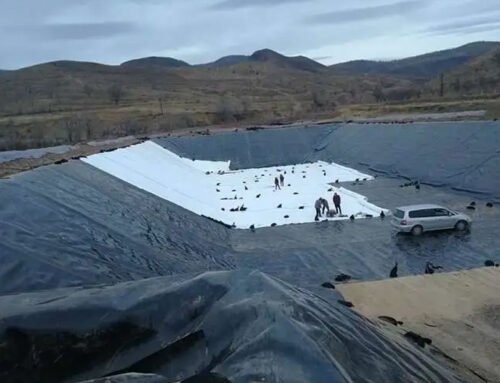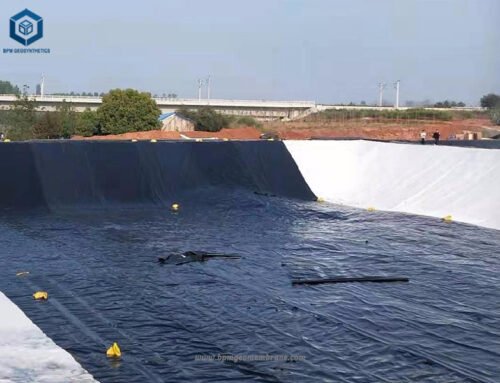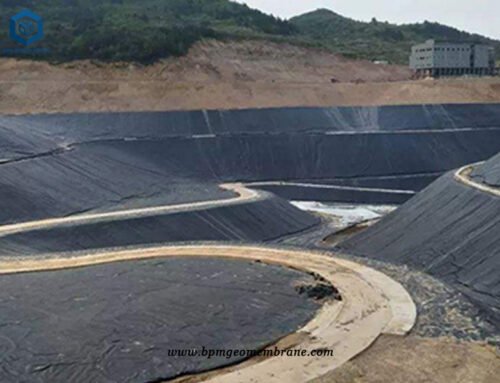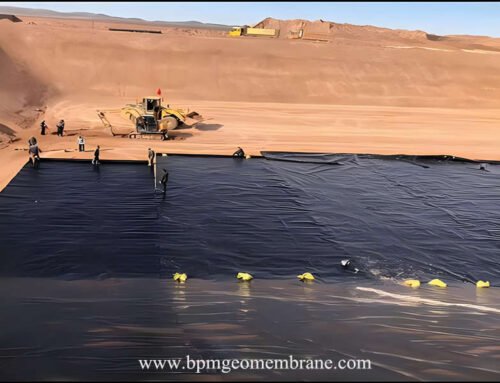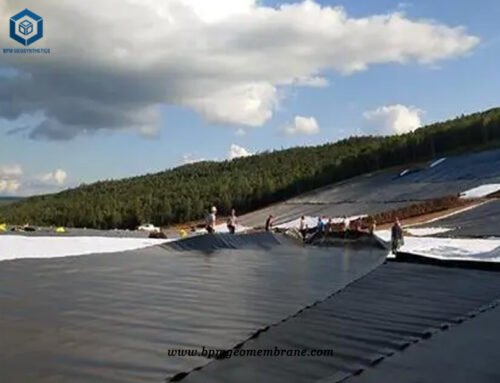Composite geomembrane is the combination of geotextile with geomembrane by calendering and hot-melt technology. The composite geomembrane product provides the advantages of both geomembrane and geotextile.
BPM Geomembrane is the leading geomembrane manufacturer and supplier, we offer complete line of geomembrane products with custom sizes at best factory price.
1. What Is Composite Geomembrane?
Composite geomembrane refers to a type of engineered material used for various geotechnical applications, particularly in the field of environmental containment and geotechnical engineering. It is composed of multiple layers that work together to provide specific properties and functionalities.
A composite geomembrane typically consists of two main layers: a geotextile layer and a geomembrane layer. The geotextile layer, often made of synthetic materials like polyester or polypropylene, enhances the tensile strength and resistance to tearing and puncturing of the composite geomembrane. It acts as a reinforcement layer, improving the overall durability and performance of the material.
The geomembrane layer, on the other hand, is typically made of a polyethylene (PE) film that provides the primary function of anti-seepage or impermeability. It serves as a barrier to prevent the passage of liquids and gases, ensuring containment and preventing leakage.
Different configurations of composite geomembranes are available, depending on the specific requirements of the project. These configurations include a single layer of geotextile with a PE film attached (referred to as a “piece of cloth”), a PE film sandwiched between two layers of geotextiles (referred to as “two cloths and one film”), or a geotextile layer between two PE films (referred to as “two membranes and one cloth”). The choice of configuration depends on factors such as the desired level of impermeability, strength requirements, and site conditions.
Among the various configurations, the two cloth-film composite geomembrane is commonly used due to its effective combination of anti-seepage properties from the geomembrane layer and enhanced strength from the geotextile layers. This configuration provides a reliable and durable impermeable barrier for applications such as landfill liners, pond liners, reservoirs, and containment systems.
Composite geomembranes are engineered materials consisting of geotextile and geomembrane layers. They offer a combination of strength, puncture resistance, and anti-seepage properties, making them suitable for a wide range of geotechnical and environmental containment applications.
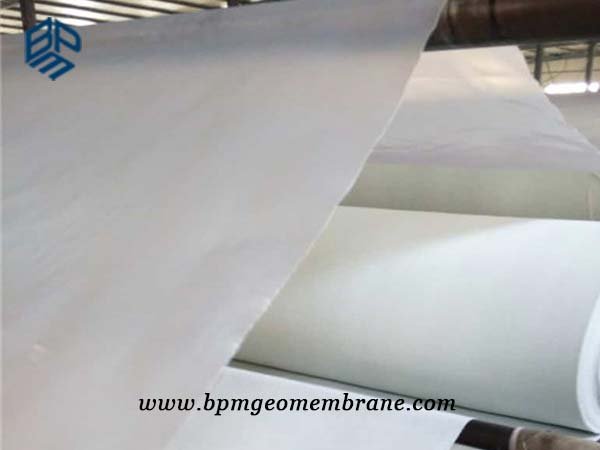
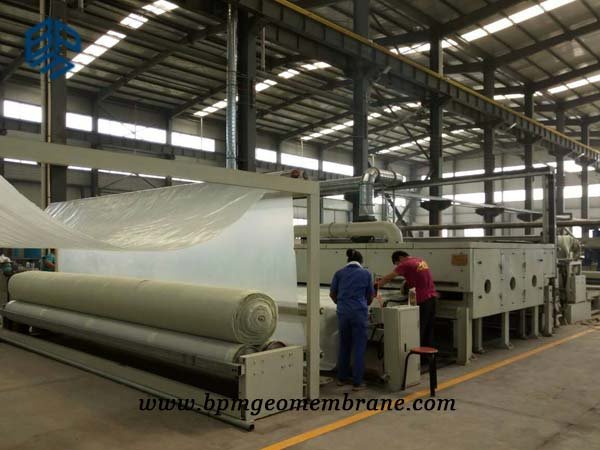
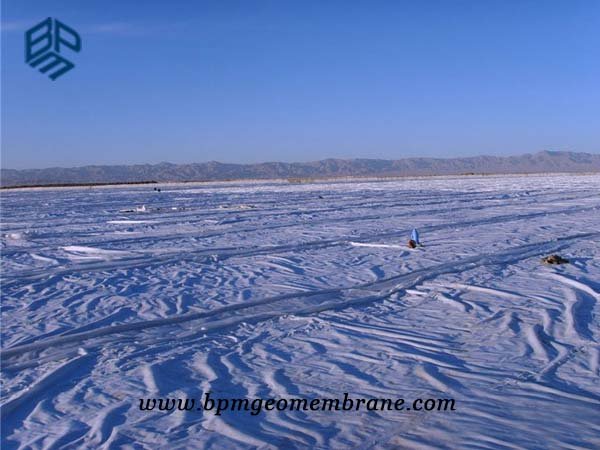
2. What Are Advantages of Composite Geomembrane?
composite geomembranes offer multiple advantages such as enhanced strength, anti-seepage properties, protection from external forces, drainage capabilities, and increased friction. These advantages make them a popular choice in numerous construction and environmental applications, providing effective solutions for projects that require reliable containment and protection against seepage. Composite geomembranes offer several advantages due to their unique construction and combination of materials. Here are some of the key advantages of composite geomembranes:
- Enhanced Strength: The inclusion of a geotextile layer in composite geomembranes significantly improves tensile strength, tear resistance, and puncture resistance. This reinforcement enhances the overall durability and longevity of the geomembrane, making it more resistant to damage during transportation and construction.
- Anti-Seepage Properties: The geomembrane layer in composite geomembranes provides excellent anti-seepage properties, preventing the passage of liquids and gases. This is particularly beneficial in applications where containment and leakage prevention are critical, such as in water conservancy projects, pond liners, reservoirs, and landfill liners.
- Protection from External Forces: Composite geomembranes with a woven geotextile layer offer protection to the underlying geomembrane from damage caused by external forces. This protection is valuable during transportation and construction activities, reducing the risk of punctures or tears that could compromise the integrity of the geomembrane.
- Drainage and Friction Enhancement: Composite geomembranes that incorporate a non-woven fabric geotextile layer can provide additional functionalities. They can act as a drainage layer, allowing water or gases to be drained away from the geomembrane surface. Additionally, the presence of the geotextile layer can increase the coefficient of friction of the membrane surface, improving stability and reducing the chance of slippage.
- Wide Range of Applications: Composite geomembranes find extensive application in various fields, including water conservancy projects, traffic tunnel projects, environmental containment, and geotechnical engineering. Their versatility and performance make them suitable for diverse projects that require reliable impermeability, strength, and protection.
BPM composite geomembrane is in line with GB/T17642-2008 standard but with high quality, competitive factory price. The composite HDPE geomembrane has a width of form 1m to 6m and the thickness is 350-1500g. It has high strength, good extension performance, large deformation modulus, acid and alkali resistance, corrosion resistance, aging resistance and good anti-seepage performance which is not affected by climate and other characteristics. Composite geomembrane is mainly used in water dams, artificial lakes, airports, construction, environmental protection, water supply and other projects.
3. Why Choose Composite Geomembrane for Artificial Lake in Weinan
The choice of composite geomembrane for the artificial lake in Weinan was based on several factors and considerations. The design department specifically selected a 200 g/0.5 mm/200 g composite anti-seepage membrane, measuring 6×50 meters per piece, to be installed at the bottom of the lake. BPM, a reputable supplier of composite impermeable geomembranes, was chosen after a thorough evaluation of prices and field inspections of multiple manufacturers.
The installation process took place between June 2017 and April 2018, during which a total of 500,000 square meters of composite geomembrane was delivered and welded by the installation team. The site supervision and leadership of the China Communications Corporation praised the installation team for their work, establishing a positive cooperative relationship between the two parties and setting a strong foundation for future collaborations.
The decision to use composite geomembrane for the artificial lake was driven by the need to prevent impoundment leakage effectively. The composite geomembrane offers excellent anti-seepage properties, ensuring that water does not leak out of the lake. Its durability, strength, and resistance to punctures and tears make it a suitable choice for providing reliable containment in water storage projects like this artificial lake.
By selecting a qualified supplier and implementing a stringent evaluation process, the project team demonstrated a commitment to quality and reliability. The successful installation of the composite geomembrane and the recognition received from the site supervision further validate the suitability and effectiveness of this choice.
The use of composite geomembrane in the artificial lake project in Weinan ensures a secure and leak-free water storage system. The collaboration between the project team and the supplier lays the groundwork for future successful ventures, emphasizing the importance of establishing strong partnerships in construction projects.
About BPM
BPM had exported many types of effective and states of the art geomembranes, geotextile and other geosynthetics to over 36 countries. We are also providing professional design and installation service. OEM and ODM are also available.
If you have any questions or inquiries, please contact us, we will reply as soon as possible.

